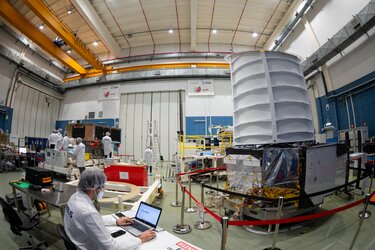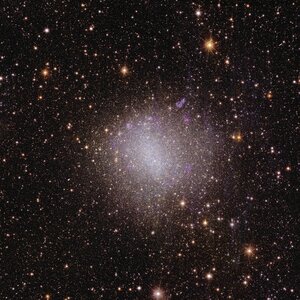Accept all cookies Accept only essential cookies See our Cookie Notice

About ESA
The European Space Agency (ESA) is Europe’s gateway to space. Its mission is to shape the development of Europe’s space capability and ensure that investment in space continues to deliver benefits to the citizens of Europe and the world.
Highlights
ESA - United space in Europe
This is ESA ESA facts Member States & Cooperating States Funding Director General Top management For Member State Delegations European vision European Space Policy ESA & EU Space Councils Responsibility & Sustainability Annual Report Calendar of meetings Corporate newsEstablishments & sites
ESA Headquarters ESA ESTEC ESA ESOC ESA ESRIN ESA EAC ESA ESAC Europe's Spaceport ESA ESEC ESA ECSAT Brussels Office Washington OfficeWorking with ESA
Business with ESA ESA Commercialisation Gateway Law at ESA Careers Cyber resilience at ESA IT at ESA Newsroom Partnerships Merchandising Licence Education Open Space Innovation Platform Integrity and Reporting Administrative Tribunal Health and SafetyMore about ESA
History ESA Historical Archives Exhibitions Publications Art & Culture ESA Merchandise Kids Diversity ESA Brand CentreLatest
Space in Member States
Find out more about space activities in our 23 Member States, and understand how ESA works together with their national agencies, institutions and organisations.
Science & Exploration
Exploring our Solar System and unlocking the secrets of the Universe
Go to topicAstronauts
Missions
Juice Euclid Webb Solar Orbiter BepiColombo Gaia ExoMars Cheops Exoplanet missions More missionsActivities
International Space Station Orion service module Gateway Concordia Caves & Pangaea BenefitsLatest
Space Safety
Protecting life and infrastructure on Earth and in orbit
Go to topicAsteroids
Asteroids and Planetary Defence Asteroid danger explained Flyeye telescope: asteroid detection Hera mission: asteroid deflection Near-Earth Object Coordination CentreSpace junk
About space debris Space debris by the numbers Space Environment Report In space refuelling, refurbishing and removingSafety from space
Clean Space ecodesign Zero Debris Technologies Space for Earth Supporting Sustainable DevelopmentLatest
Applications
Using space to benefit citizens and meet future challenges on Earth
Go to topicObserving the Earth
Observing the Earth Future EO Copernicus Meteorology Space for our climate Satellite missionsCommercialisation
ESA Commercialisation Gateway Open Space Innovation Platform Business Incubation ESA Space SolutionsLatest
Enabling & Support
Making space accessible and developing the technologies for the future
Go to topicBuilding missions
Space Engineering and Technology Test centre Laboratories Concurrent Design Facility Preparing for the future Shaping the Future Discovery and Preparation Advanced Concepts TeamSpace transportation
Space Transportation Ariane Vega Space Rider Future space transportation Boost! Europe's Spaceport Launches from Europe's Spaceport from 2012Latest

Eye of Euclid
Thank you for liking
You have already liked this page, you can only like it once!
The 1.2-m diameter main mirror of ESA’s Euclid mission to unveil the dark Universe, seen during assembly, integration and testing. Using this mirror, the spacecraft will map the 3D distribution of billions of galaxies up to 10 billion light years away – looking beyond the Milky Way galaxy to image around a third of the observable Universe. By revealing the Universe’s large-scale structure, and its pattern of expansion, the mission will cast light on the mysterious dark energy and dark matter making up 95% of the cosmos.
All six of Euclid’s ‘Korsch configuration’ mirrors, plus the telescope itself – comprising more than 30 parts as well as the mirrors – as well as the more than 10 parts making up the mission’s Near Infrared Spectrometer and Photometer and the optical bench that surrounds them are all made from the same material: not glass, but a ceramic only found naturally in space.
Silicon carbide (SiC) is one of the hardest materials known, used to make cutting tools, high-performance brakes and even bulletproof vests, while being much lighter than glass. It is similar to a metal in having high thermal conductivity but unlike metals can undergo extreme temperature shifts without deforming – making it very attractive for space-based astronomy.
SiC is relatively common in space – formed from the combination of silicon and carbon in the absence of oxygen – and small amounts of it have been found within meteorites. On Earth it was first synthesised as an artificial diamond substitute.
Realising its potential for space, ESA and Airbus (developing Euclid’s payload module) entered into a long-term technical collaboration with French company Mersen Boostec, born out of a terrestrial firm which previously manufactured SiC bearings and seals for industrial pumps. The company made the 3.5-m diameter main mirror for ESA’s Herschel spacecraft – which when the mission launched in 2009 was then the largest telescope mirror flown to space – and went on to produce mirrors and optical supports for Rosetta, Gaia, the James Webb Space Telescope and now Euclid.
“Gaia’s monolithic rectangular main mirror had a wider diameter at 1.5 m across, but Euclid’s main mirror represents our company’s largest made-in-one circular mirror,” explains engineer Florent Mallet of Mersen Boostec.
The company's SiC Product Line Director, Jérôme Lavenac, adds: “We’re proud of our contribution to Europe’s latest space astronomy mission, which will lead to major advances in fundamental physics.”
The main mirror’s manufacturing process began with SiC powder which was squeezed into a solid but soft circular block which was then precisely shaped using a computer-guided milling machine. The next step was ‘sintering’ or baking it in a 2100°C oven. The resulting hard ceramic was then coated with additional SiC using chemical deposition, to fill in any residual pores, to a thickness of a few tenths of a millimetre. The mirror was then ground slightly before being passed to the Safran-Reosc company for polishing and silver coating. The final mirror shape is accurate to nine millionths of a millimetre under Earth gravity.
Both of Euclid’s instruments will make use of this mirror plus its five smaller ones. Euclid’s VISible instrument (VIS) takes very sharp images of galaxies in visible light over a much larger fraction of sky than would be possible from the ground. VIS works alongside the Near Infrared Spectrometer and Photometer (NISP). NISP sifts infrared light coming from these galaxies to derive key data, including their speed of outward expansion – measuring their ‘redshift’, on the same principle as a police radar gun, which will in turn allow astronomers to infer the expansion history of the Universe.
-
CREDIT
Airbus -
LICENCE
ESA Standard Licence

Euclid in Turin, Italy

XMM-Newton shows million-degree gas in Abell 2390

Instruments installed on Euclid spacecraft

Structural and thermal model of the Euclid satellite















 Germany
Germany
 Austria
Austria
 Belgium
Belgium
 Denmark
Denmark
 Spain
Spain
 Estonia
Estonia
 Finland
Finland
 France
France
 Greece
Greece
 Hungary
Hungary
 Ireland
Ireland
 Italy
Italy
 Luxembourg
Luxembourg
 Norway
Norway
 The Netherlands
The Netherlands
 Poland
Poland
 Portugal
Portugal
 Czechia
Czechia
 Romania
Romania
 United Kingdom
United Kingdom
 Slovenia
Slovenia
 Sweden
Sweden
 Switzerland
Switzerland
























